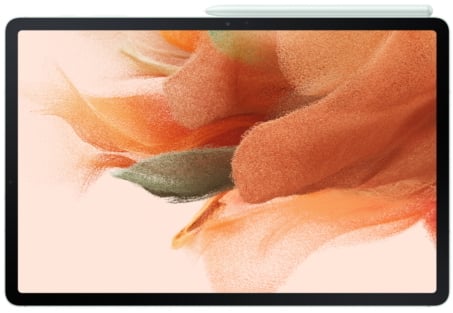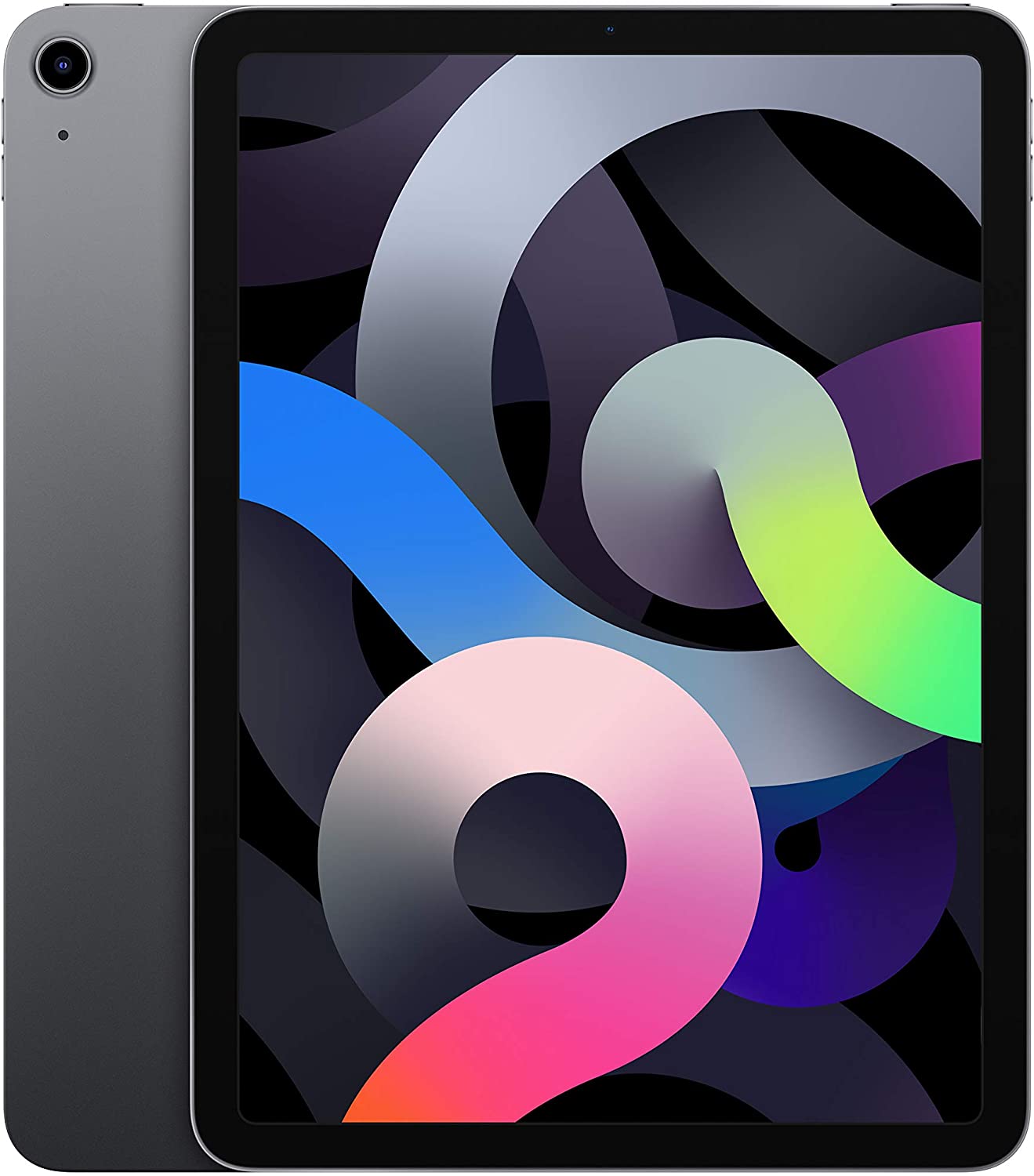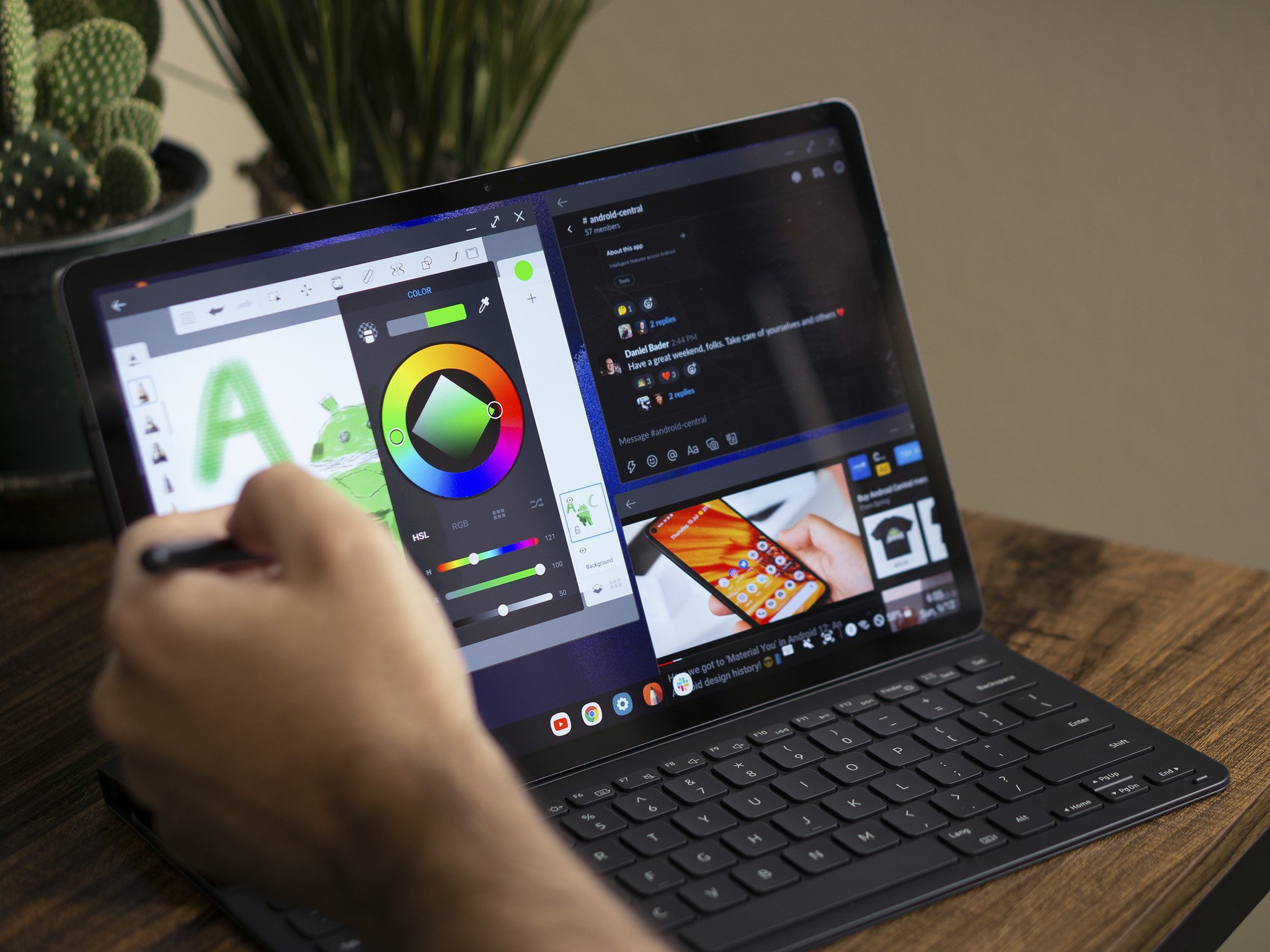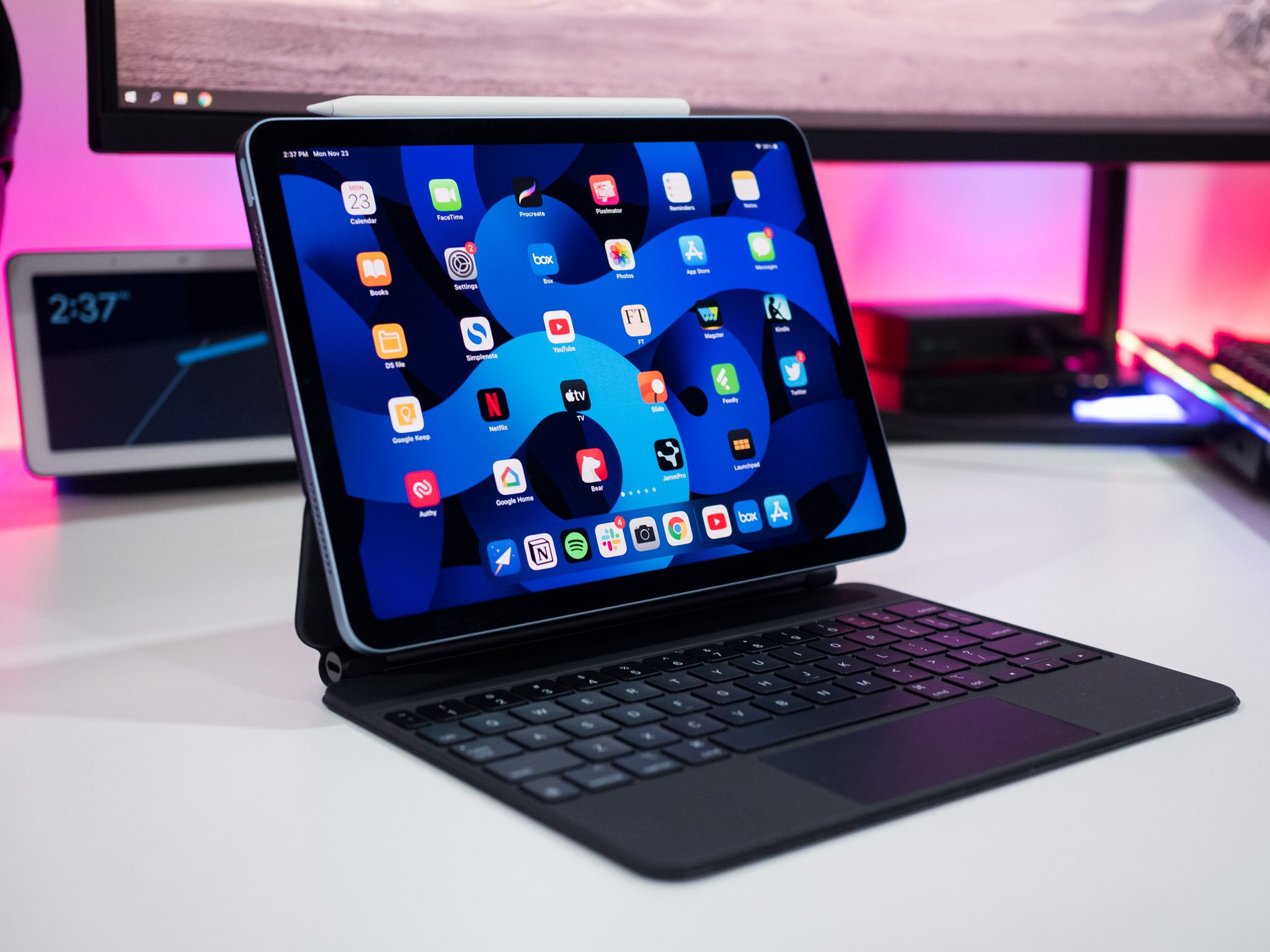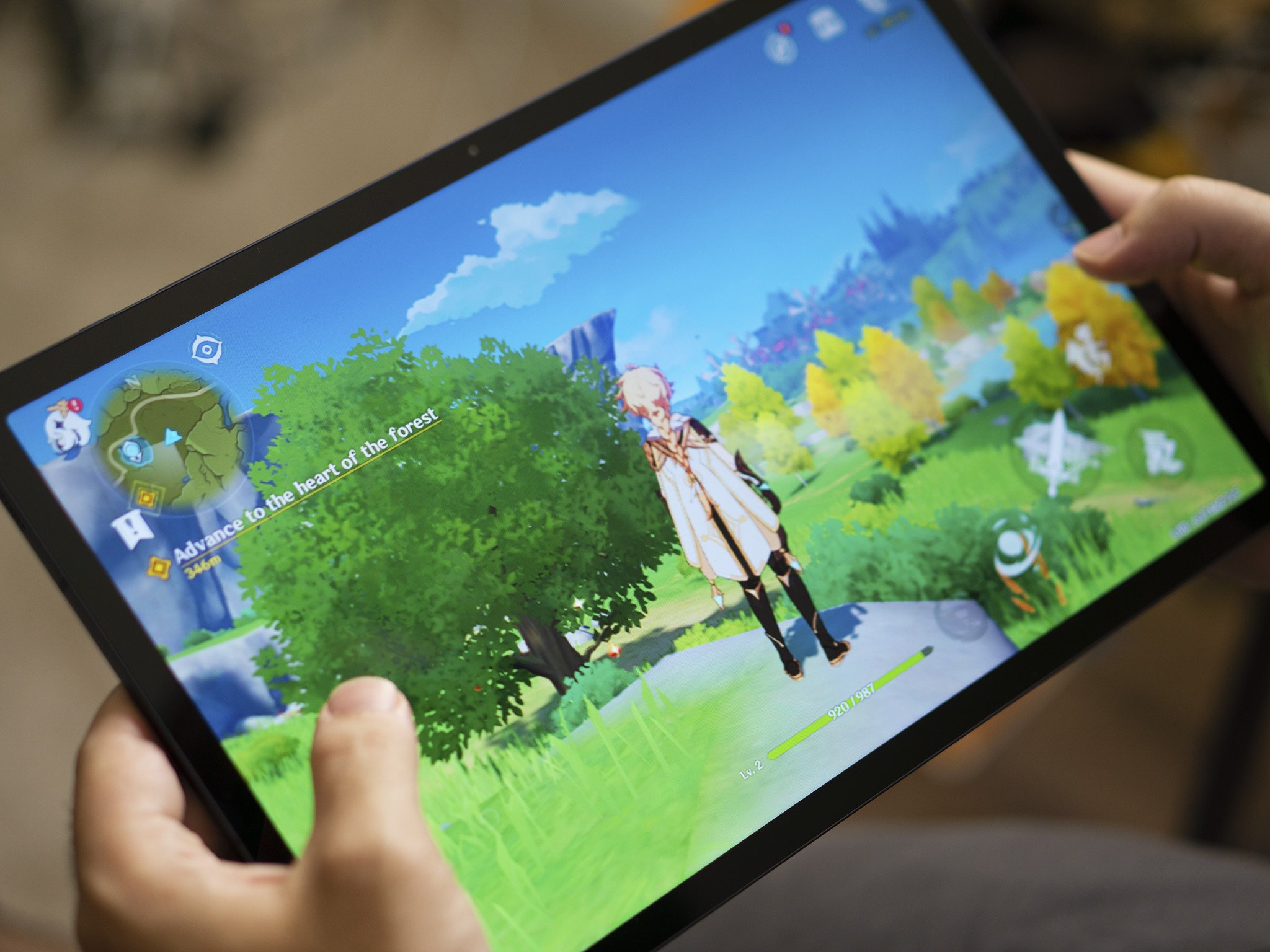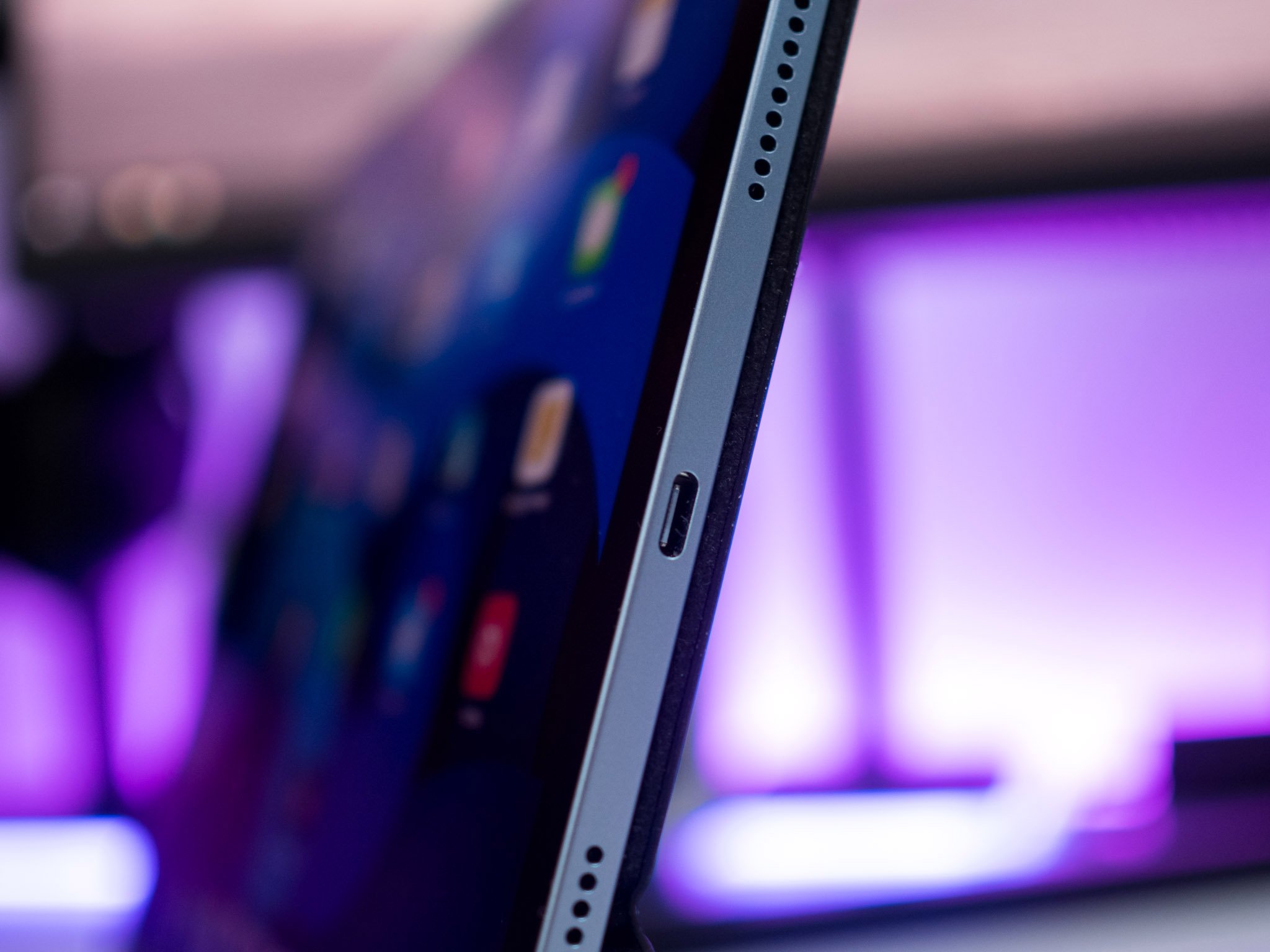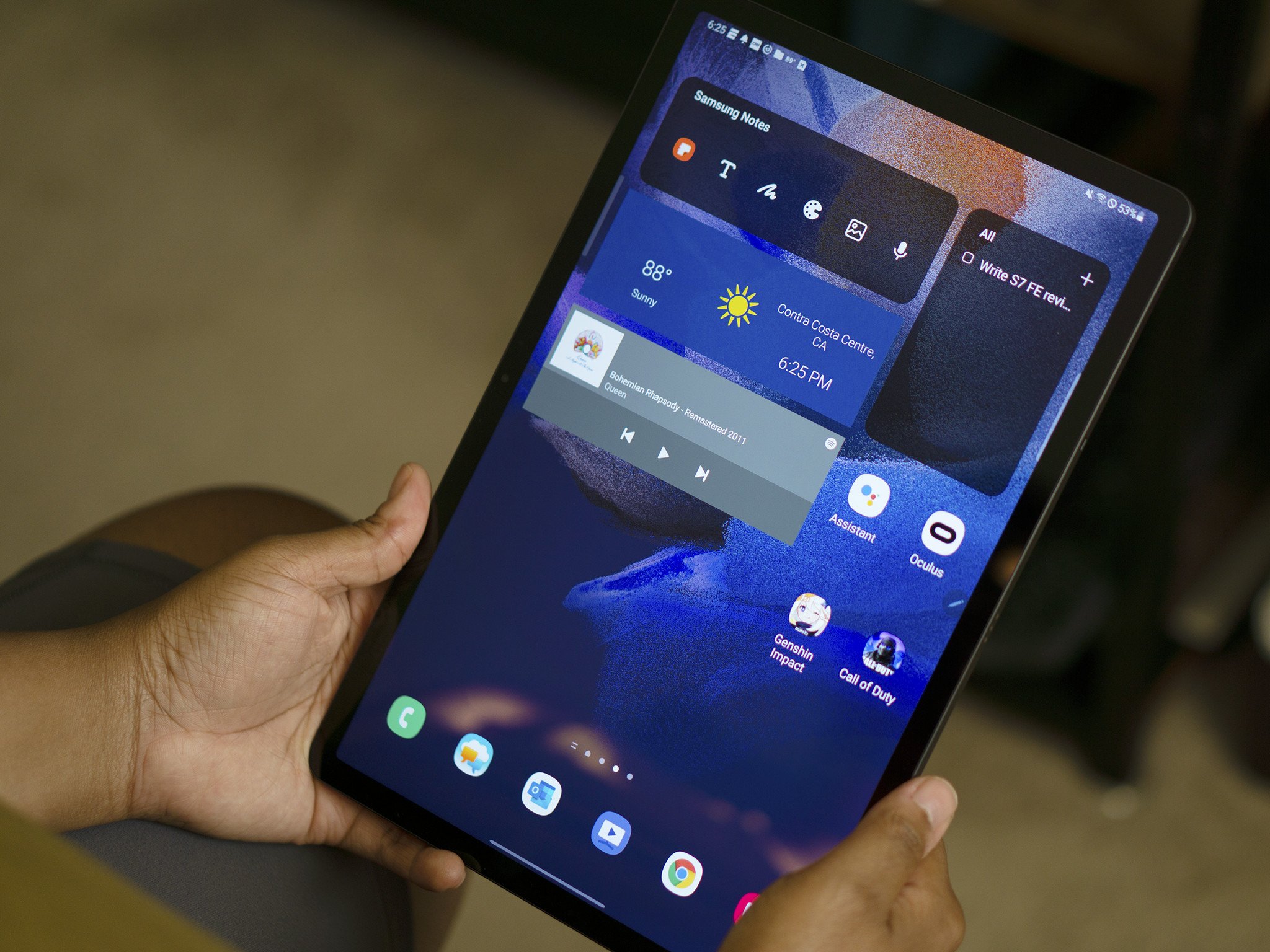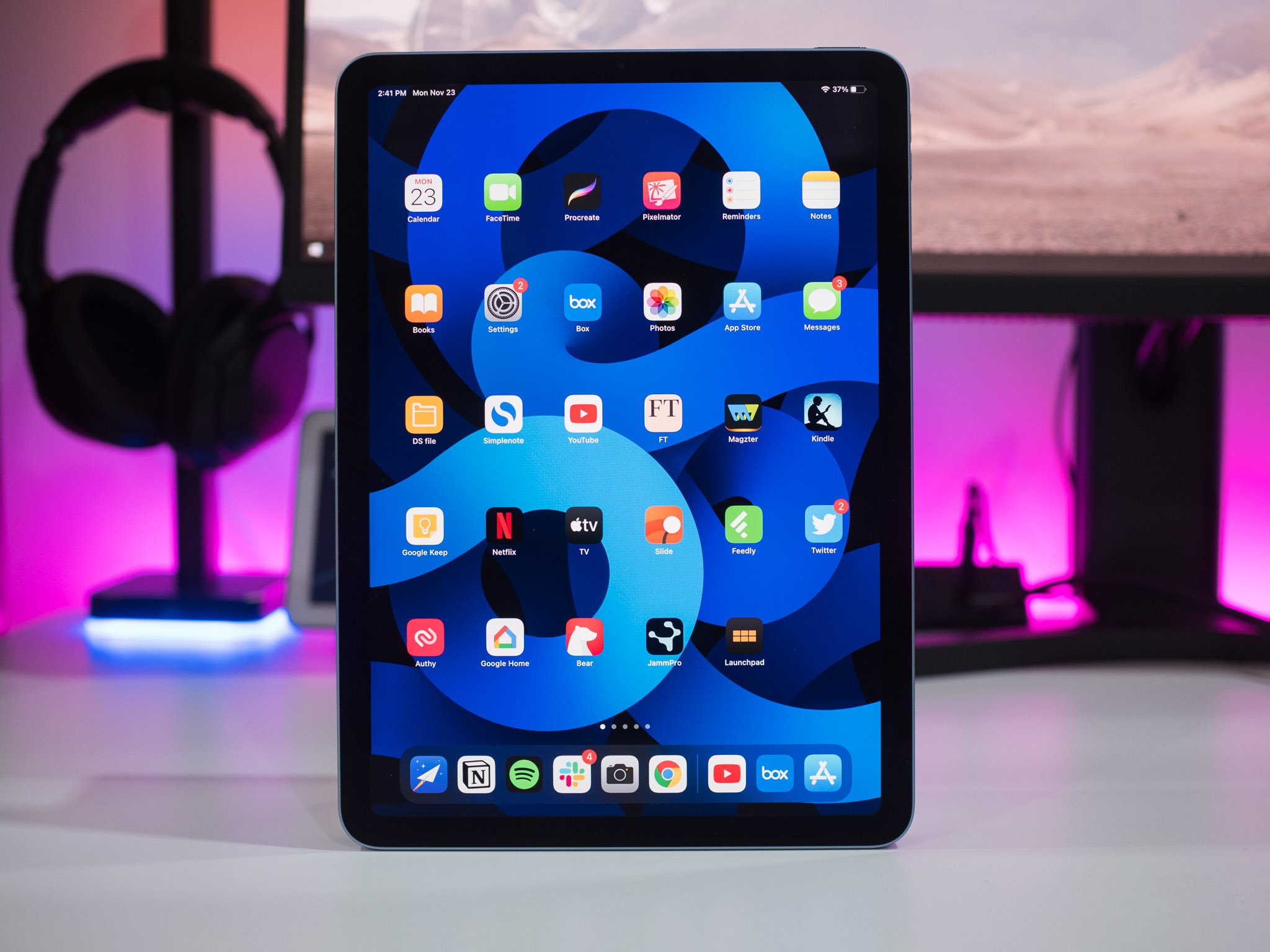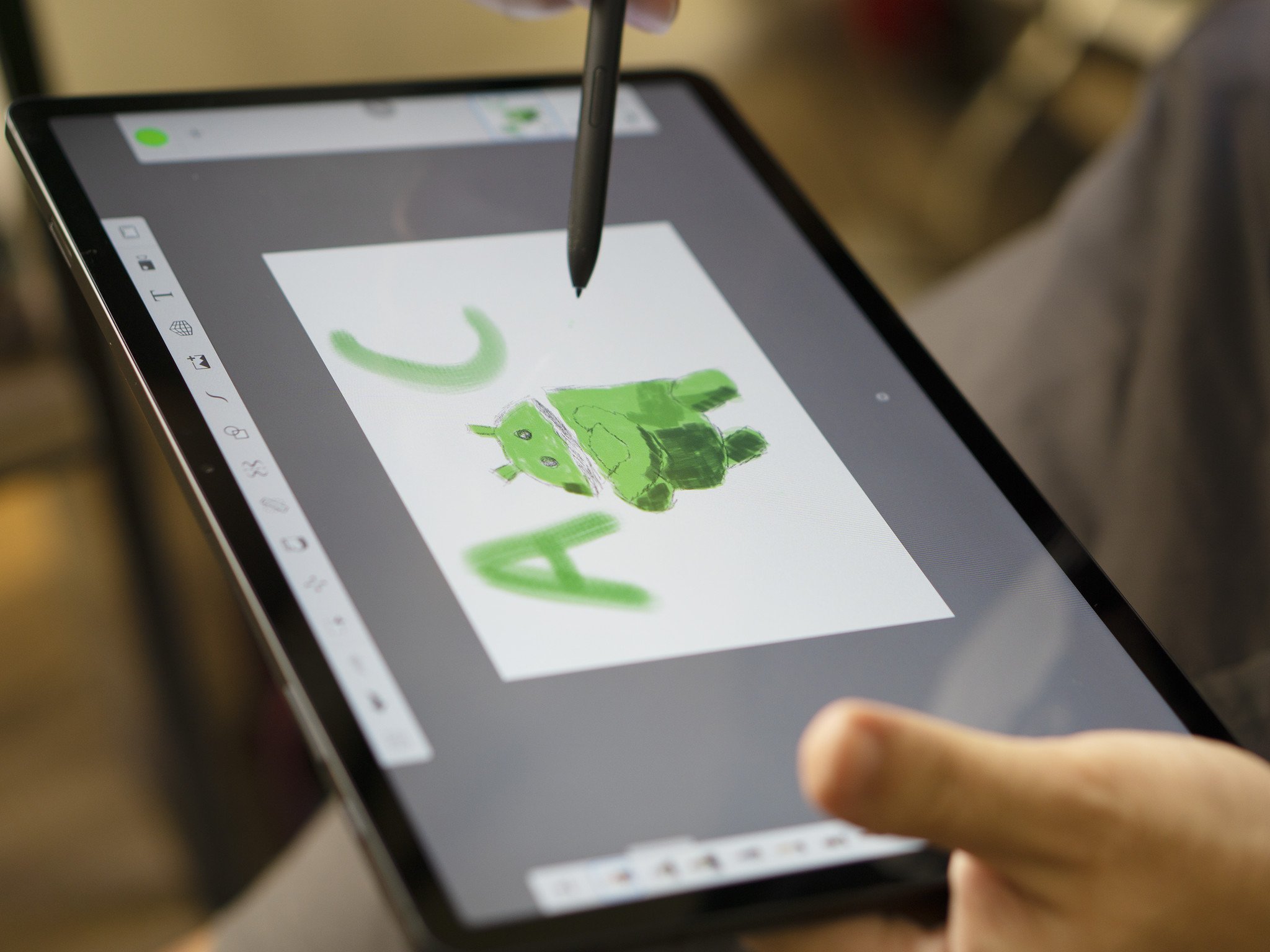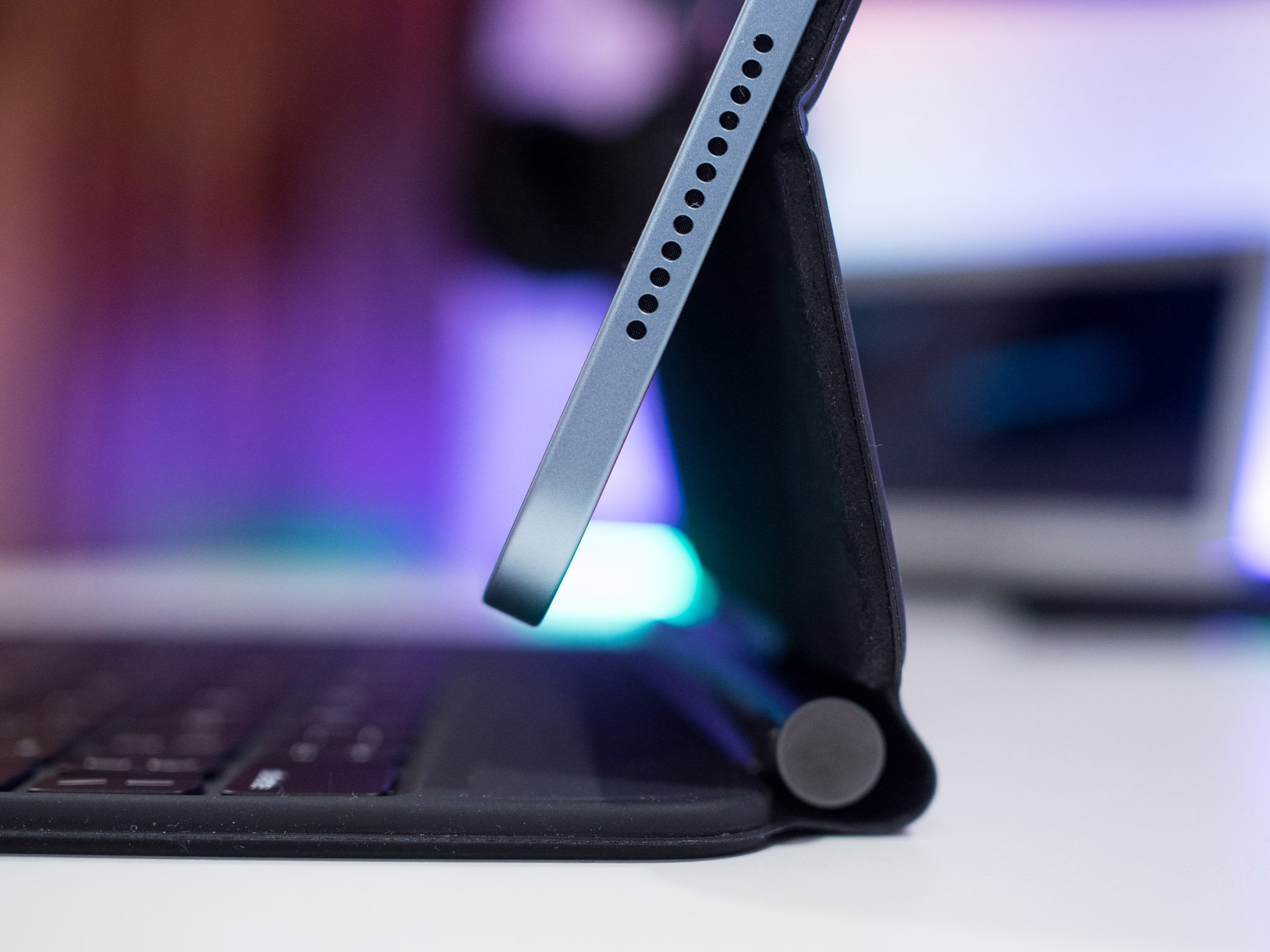Best for Galaxy users
Samsung Galaxy Tab S7 FE
Pros
- Larger, higher-resolution display
- Comes with an S Pen
- 5G connectivity option
- Use like a laptop with accessories
Cons
- Likely to be expensive
- Might be more than you need
The Samsung Galaxy Tab S7 FE is the obvious choice if you live within the Android ecosystem, offering a compelling tablet experience from one of the best brands in the business. It's the perfect productivity tool, particularly for a Galaxy smartphone owner, that can be used for work, plus some play during downtime.
Ideal for iOS users on a budget
iPad Air (2020)
Pros
- Decent starting price
- Use like a laptop with accessories
- Powerful chip
- LTE cellular option
Cons
- Smaller, lower-resolution screen
- Only best for those with other Apple devices
- Doesn't come with Apple Pencil
For those who live within the Apple ecosystem and are on a budget, the iPad Air (2020) is a decently priced entry into the premium tablet market that you can expand over time with the addition of other optional accessories, like the Magic Keyboard and Apple Pencil.
Just like in the smartphone world, with tablets, it's often a debate between Samsung Galaxy and Apple iPad. When looking at the new Samsung Galaxy Tab S7 FE vs. iPad Air (2020), it might be easy to assume that newer is better and the former model makes the most sense. But that isn't always the case. The 2020 version of the iPad Air is still a solid, feature-rich, premium tablet that can measure up. In fact, we even named it the best Apple tablet for students.
With that said, which one you buy truly depends on which ecosystem you like best. If you own other Apple devices at home, like Apple TV, iPhone, or an Apple Watch, there's a lot of seamless connectivity you can enjoy among them all. The same goes for Samsung and its devices that work perfectly with the Galaxy Tabs, like its smart TVs, Galaxy phones, and more.
However, if you aren't really tied to either ecosystem, choosing between these two can be difficult. To help break things down, let's look at how they compare to core specs.
| Samsung Galaxy Tab S7 FE | iPad Air (2020) | |
|---|---|---|
| Screen Size | 12.4 inches | 10.9 inches |
| Screen Resolution | 2,560x1,600 WQXGA | 2,360x1,640 Liquid Retina IPS LCD |
| Connectivity | Wi-Fi, Bluetooth 5.0, Wi-Fi Direct, 5G, LTE | Wi-Fi 6, Bluetooth 5.0, LTE/3G option |
| Speaker | Dual stereo speakers (sound by AKG), Dolby Atmos | Stereo speakers (in landscape mode) |
| Camera | Rear 8MP AF, front 5MP | Rear 12MP, front 7MP |
| Processor | Octa-core processor (2x2.2GHzm 6x1,8GHz) | Hexa-core (2x3.0GHz Firestorm + 4x1.8GHz Icestorm) |
| Colors | Mystic Black, Mystic Silver, Mystic Green, Mystic Pink | Space Gray, silver, Rose Gold, green, Sky Blue |
| Comes With | Magnetic S-Pen | Apple Pencil sold separately |
| Operating System | Android 11 | iPadOS 14.1 (upgradeable to 14.6) |
| Internal Memory | 64GB, 128GB (expandable up to 1TB via microSD card) | 64GB, 256GB |
| Memory | 4GB RAM | 4GB RAM |
| Battery Life | Up to 13 hours | Up to 10 hours |
| Dimensions | 185 x 284.8 x 6.3mm | 247.6 x 178.5 x 6.1mm |
| Weight | 608 g | 458 g Wi-Fi, 460 g 3G/LTE |
There are some pretty noticeable differences between these two tablets, including the physical size and the screen resolution, processors, battery life, and more. So let's dig deeper into how they compare.
Samsung Galaxy Tab S7 FE vs. iPad Air (2020): Physical appearance
These two tablets look pretty different from one another. While the iPad Air is slightly slimmer — a key feature of the Air line — it is bigger, despite boasting a screen almost 2 inches smaller. Samsung packs a lot of screen into a smaller footprint, giving you more viewing area for sketching, surfing websites, watching movies, and more. With that said, the Galaxy Tab S7 FE is significantly heavier than the iPad Air (2020) and a tad thicker, so if you're looking for something with maximum portability, this could be a deciding factor.
Both have pretty high-resolution screens, but again, when it comes down to the specs, the Galaxy Tab S7 FE has the iPad Air (2020) beat with slightly higher figures.
You can get either tablet in basic colors like silver and black for the Galaxy, gray for the iPad. But each also comes in some unique additional finishes like green and pink with the Galaxy and Rose Gold, green, or Sky Blue with the iPad. So if you like the tablet to show off your style, you might love having options for both of these. Though chances are you'll use a protective case anyway.
Speaking of which, both work with the brand's own specially designed covers and accessories for a laptop-like experience. For example, the Galaxy works with the Book Cover Keyboard and the Apple with the Magic Keyboard and Smart Keyboard Folio or Smart Folio Covers. Keep in mind, however, that while both work with the respective styli technology — the Galaxy with the Samsung S Pen and the Apple with the Apple Pencil, the Galaxy Tab S7 FE comes with the S Pen in the box whereas with Apple, you have to buy the Pencil separately. This should be factored into the overall cost if you plan to use it for productivity purposes that require or could benefit from a feature-rich stylus.
Samsung Galaxy Tab S7 FE vs. iPad Air (2020): Power and specs
The Galaxy Tab S7 FE is powered by an octa-core processor while the iPad uses Apple's A14 Bionic chip and a Hexa-core processor, which will presumably result in a faster and more robust performance in the latter, particularly for gaming, 4K videos, art creation, and other intensive activities. But it will all depend on what you're doing. Both offer pretty powerful processing with 4GB RAM that's nothing to sneeze at when it comes down to it.
The Tab S7 FE's battery runs for up to 13 hours per charge, while the iPad Air (2020) is only rated up to 10 hours (nine if you're using cellular connectivity). It's the difference between completing a day's work or enjoying a few movies without having to plug in. Three hours is a lot of time.
Connectivity-wise, both offer cellular connectivity options, but the Wi-Fi + Cellular option of the iPad Air (2020) costs significantly more than the Wi-Fi-only version. The Galaxy Tab S7 FE, meanwhile, will presumably only come in one version with cellular connectivity (though with both, a carrier subscription is also required). What's more, the Tab S7 FE offers LTE and 5G, whereas the older-model iPad includes LTE and 3G connectivity, though also Wi-Fi 6, which is an ultra-fast technology. If you don't plan to use a cellular connection and can just hotspot to your phone or use a public Wi-Fi network while on the go, this won't matter, and the iPad Air (2020) without cellular connectivity might be the better-value purchase. But if you do want cellular connectivity, you may be better off going the Galaxy route.
Both also offer Wi-Fi and Bluetooth 5.0 connectivity. But keep in mind that this version of the iPad Air does away with the 3.5mm headphone jack, which means you'll have to use wired headphones with a Lightning connector, get a Lightning-to-3.5mm adapter to plug in (this means you can't charge the tablet and listen via headphones at the same time), or use wireless headphones. Wireless is the trend these days anyway. Nonetheless, sometimes it's nice to have the backup option of a 3.5mm headphone jack, and only the Galaxy Tab S7 FE has one between the two.
Storage-wise, the Galaxy Tab S7 FE comes with 64GB or 128GB of storage, while the iPad Air (2020) comes in either 64GB or 256GB. That's a big jump, but the reason is that you cannot expand the storage in an iPad, whereas you can buy an optional microSD memory card and expand the storage of the Galaxy Tab S7 FE to up to 1TB. Of course, Apple users might prefer the cloud anyway, particularly Apple's iCloud service. But if you want to store and access your files locally and have a lot of large files, even 256GB might not be enough.
Both have pretty decent cameras. The S7 FE has an 8MP rear with autofocus and a 5MP front camera for selfies and video calls, while the iPad Air has a 12MP rear camera and a 7MP front FaceTime camera. A neat feature of the Galaxy tablet ensures you're kept in the center-screen if the tablet is turned to landscape orientation, ensuring video calls always look great. It has three microphones around the display as well. Both have dual speakers though the Galaxy also includes support for Dolby Atmos to enjoy immersive listening experiences.
Samsung Galaxy Tab S7 FE vs. iPad Air (2020): Other considerations before choosing
Both of these tablets are designed for productivity and creative use, so you will likely want to invest in accessories for them, like a keyboard and stylus (as noted, the Galaxy already comes with the S Pen, which is a big bonus).
For business types, there are a lot of bonuses with the Tab S7 FE, including Multi-Active Window that lets you open three apps at once. Then, there's App Pair for saving and launching your favorite pairs of apps together in one click. Second Screen is nifty for using the tablet as a secondary display with a PC and Samsung DeX compatibility. Samsung Notes is also included.
For creative types, the S7 FE comes with a six-month trial to Clip Studio Paint and Canva, as well as free Noteshelf for taking colorful notes with the S Pen, unlimited access to Samsung TV Plus, and its 160+ channels, and a free trial of YouTube Premium.
Of course, the iPad Air (2020) works seamlessly with other Apple devices and those that feature technologies like AirPlay, so you could easily mirror content from the tablet to the big screen, sync up with your phone or Apple TV. It also has the Scribble to iPad feature, which lets you handwrite in any text field. There are also note-taking options and smart selection that can distinguish handwriting from drawings, so you can easily select, cut, and paste as you work. It even has a cool shape recognition feature and a data detector to recognize phone numbers, dates, addresses, and web links.
Samsung Galaxy Tab S7 FE vs. iPad Air (2020): Which should you buy?
When looking at the Galaxy Tab S7 FE vs. iPad Air (2020), both of these tablets offer great value for money, and the decision is evident if you already exist within the Samsung Galaxy or Apple camps. But if you're on the fence, it can be a tough choice.
Both have features that will work beautifully for productivity and creative types. However, you might appreciate the larger screen size of the Galaxy model (keep in mind that it also comes with additional weight even though it is slightly smaller dimensions). Both work with tons of accessories, but the inclusion of the S Pen in the box with the Galaxy S7 FE is a massive bonus if you plan to use a stylus. Unfortunately, the Apple Pencil doesn't come cheap.
If you plan to save a lot of files and don't like using cloud storage, the Galaxy S7 FE might be the better option since you can expand local storage to up to 1TB via a microSD card.
Battery life could be a dealbreaker, though, and the Galaxy S7 FE can last up to three hours longer than the iPad Air (2020), which is essential for frequent travelers or those who will want to use it on the go when they can't always get to a power outlet to recharge.
Also important for travelers are the connectivity options: With a 5G option, the Galaxy Tab S7 FE might make more sense if you would use it. However, if you wouldn't, both offer powerful Wi-Fi and processors to keep you connected and moving quickly to get all your tasks done. If you want to keep using wired headphones, though, don't forget that the iPad Air (2020) does not have a 3.5mm headphone jack.
Powerful productivity
Samsung Galaxy Tab S7 FE - 2021 Android Tablet
Workhorse option
From $530 at Amazon From $530 at Best Buy From $530 at B&H Photo
Suppose you're looking for an excellent tablet that you can use to get work done on the go as well as enjoy entertainment, from watching movies to surfing websites, sketching, reading the news, playing games, and more. In that case, the Galaxy Tab S7 FE checks plenty of boxes and will fit the bill, no matter your needs.
On-the-go tablet
iPad Air (2020) - (4th Generation)
Take it with you
From $539 at Amazon From $600 at Best Buy From $600 at B&H Photo
The iPad Air line-up is designed to be ultra-thin and lightweight, perfect for taking with you wherever you go. If you plan to use it mainly on the go, popping it into your bag when needed, this is a great option. You'll get decent battery life and a powerful experience with Apple's A14 Bionic chip. There are some sacrifices, but for Apple users, it's an affordable tablet worth considering.
Source: androidcentral
